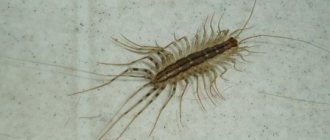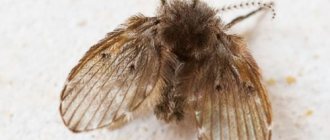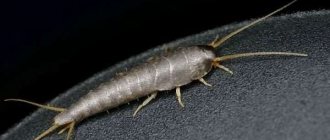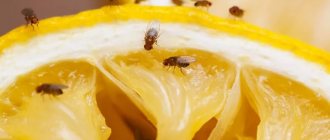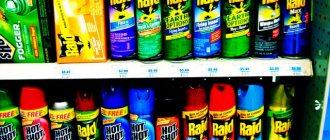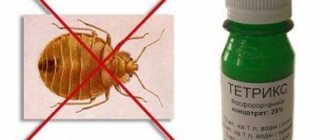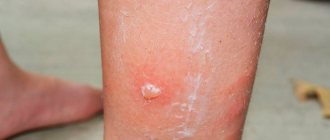If you have a butterfly or sewer fly, you can choose how to get rid of it from several options. To combat these insects and their larvae, the following are used:
- Folk and improvised means
- Household chemicals
- Insecticides
- Professional SES processing
It is highly advisable to combine any treatment with preventive measures, which is why this instruction for exterminating butterflies will begin with them.
How to deal with butterflies
Before you start directly baiting insects, you need to eliminate the causes of their appearance and block the paths through which they entered you. This will not only make any treatment more effective, but will also help prevent the pests from returning.
- If the room where butterflies are infested has been in need of cosmetic or major repairs for a long time, do it.
- Balance heat and humidity levels by using radiators or installing power-controlled heated towel rails.
- Repair all cracks and damage in tile joints.
- Clean the ventilation in the room and install small mesh in it that allows air to pass through but traps insects.
- During the warm season, insert mosquito screens or nets into open window frames.
- Check the integrity of water and sewer lines and, if necessary, repair them.
- Inspect the faucets and plumbing wiring and, if any, repair any leaks.
If butterflies live not only in your apartment, but also somewhere in the house, you additionally need to contact your management company with a request to understand the situation and carry out emergency disinfestation.
In parallel with eliminating the causes of insects, you can begin to select methods and means for exterminating parasites directly in your apartment. How and with what can you fight butterflies?
Reasons for appearance
The main reasons for the appearance of the pest are excessive humidity and dampness. A favorable environment for the life of sewer flies is:
- kitchen (sink);
- bathroom;
- basement or attic space;
- non-functional ventilation soaked in moisture.
Important: moving around the apartment, butterflies spread dampness.
Even if the apartment is clean and has moderate humidity, insects can still appear. When a butterfly infests a neighbor's house, it spreads through the sewer pipes throughout the multi-story building.
How to get rid of butterflies in the bathroom
Butterflies are most often found in bathrooms, as this is where the most comfortable conditions for the life and reproduction of insects are created.
Handicraft and improvised means
- Mix 9% table vinegar with water in a 1:1 ratio in a spray bottle and apply the mixture to the bathtub, sink, toilet and tiles.
- Seams and joints can be treated with a solution of 10 grams of boric acid and 0.5 liters of water. Apply the mixture, leave it overnight, and rinse with hot water in the morning.
- Pour a glass of undiluted 9% apple cider vinegar or table vinegar directly into the drain and add 3 tablespoons of soda. Leave for 30 minutes, rinse with boiling water from the kettle, and rinse the drain with a stream of tap water.
- Pour 1 liter of Coca-Cola into the drain, leave for 10 minutes, thoroughly rinse off the soda with boiling water, and rinse the drain with tap water.
Household chemicals
Another way to get rid of butterflies in the bathroom is to use household chemicals to clean plumbing fixtures, bathroom surfaces and clogged pipes. Suitable for this:
- Tiret
- Dosia
- Frosch
- Cillit Bang
- Deboucher Active
- Prosept Bath DZ
- Tri-Bio
- HG Duo Unblocker
- Domestos
You can use any other brands of products from this category. Before use, read the instructions on the package and find out for which surfaces the selected composition is safe.
Insecticides for use in the bathroom
To destroy butterfly larvae and adult flying individuals, you can also use special insecticides. Suitable:
- Scabengel
- Contra Insect
- Aerosol Delicia
- Avalon
- Empire 20
- Delta Zone
- Master 250 MKS
- Aerosol Combat Multispray
- Tetrix
Use all products only according to the instructions on the package. When processing, use gloves, a respirator and goggles for protection and wear closed clothing.
How to remove sewer flies or butterflies
Have you ever seen a small insect in the kitchen or bathroom, similar to a moth, but smaller? Most likely, there is a butterfly in the house!
It lives in places with high humidity, for which it is nicknamed the sewer fly. Is she dangerous? How to remove sewer flies or butterflies?
Features of an adult
Archaeologists and biologists assure: butterflies have been known since the Jurassic period, when sewers, as such, did not exist at all.
How did this fly manage to adapt to our homes?
Appearance
Butterflies are a large family of insects belonging to the suborder Long-whiskers and the order Diptera. The world fauna includes more than 2,500 species.
Butterflies are common all over the globe, and two hundred species live in the CIS alone! What sewer flies look like, a photo of the insect, enlarged several times, allows you to see this. Externally, they are small mosquitoes, no more than half a centimeter in size, similar to night moths.
Butterfly
The body of the insect is covered with fluff; small villi are located on paired wings. The color of the butterfly ranges from light gray to brownish. Some people mistake it for a moth, wondering where it came from in the absence of fur and woolen items in the toilet and bathroom. Meanwhile, dampness is what attracts this furry baby butterfly.
Life cycle and reproduction
To attract a butterfly male for mating, the female has special glands that secrete a specific secretion. A short time after mating, the female lays eggs. Each clutch consists of several dozen eggs.
Butterflies lay them in places where there is an abundance of decomposing waste and it is sufficiently warm and humid. Downpipes ideally meet these requirements. The eggs are cream to brown in color; within 1.5-2 days after laying, butterfly larvae hatch from them (the photo allows you to see them in great detail, while it is not easy to see them with the naked eye). It takes one to two weeks for the larva to transform into an adult.
Life cycle of the Butterfly
What do sewer butterflies eat? The fly larva, a photo of which shows that it resembles a caterpillar, has a mouthpart. The mucous formations that cover the pipes from the inside are suitable for feeding the larvae. The life cycle of an insect in the adult stage does not exceed three weeks.
How dangerous are butterfly flies?
Is the butterfly fly dangerous for humans? No. There has been no evidence that the sewer moth carries infections. Theoretically, it is capable of infecting food, since it carries bacteria from trash cans and pipes on its legs.
To a certain extent, this insect can be called useful. The butterfly larva that lives in the pipes helps break up blockages, and the drain works without problems. The fly does not damage clothing, furniture, or finishing materials. In general, it coexists with humans very peacefully.
The only inconvenience that this dipteran causes is purely aesthetic. Who would like to have flies flying around the house? They reproduce quite quickly, and therefore significantly annoy their owners. Butterflies fly slowly, over short distances, perching on walls and ceilings.
Presumably, insects can cause exacerbation of the disease in people predisposed to allergic reactions to insects. Some people complain that sewer flies bite, but this fact has not been scientifically proven.
How do sewer flies appear in an apartment?
Sewer flies enter our homes through pipes and through cracks in the floors and walls, and rise from damp, warm basements. If the neighbors are not clean, and there is mold in their apartment and there is a lot of rotting food, then flies can spread from them.
Sewer fly
A butterfly feels at ease in the bathroom, especially if general cleaning of the room is carried out rarely. Mold and organic deposits accumulate in the corners and joints of walls, floors, and in the seams between ceramic tiles, which attracts these furry insects.
Fighting methods
A person’s home is his personal territory. Few people are willing to put up with the proximity of insects. We poison cockroaches and get rid of flies. And there is no place for a butterfly in an apartment. What are sewer flies afraid of? How to deal with their invasion?
It is easy to conquer territory from butterflies if there are one or two midges flying around the house. The mechanical method of fighting is simple: just slam the fly sitting on the wall. But if butterflies attack en masse, what should you do?
Chemicals
Chemistry is something that all insects are afraid of, including the butterfly. How to get rid of it at home using chemicals? Aerosol insecticides are the easiest to use against most winged intruders.
Sprays are sprayed in areas that need treatment: bathroom, toilet, kitchen and, if necessary, living rooms. Then close the doors tightly and leave the disinfected area for several hours.
It is necessary to exclude the presence of children and animals in the room during processing, and to pack food tightly, put it in the refrigerator, cabinets or take it out of the kitchen.
Then all rooms are ventilated and wet cleaned using disinfectants.
What aerosols are suitable? Often, any against flying insects, for example:
- "Medilis Cyper";
- "Dichlorvos";
- "Destructive force";
- "Raid";
- "Raptor";
- "Combat" and others.
In addition to the use of “chemical weapons,” it is necessary to clean the wastewater with ammonium salts. 200 grams of powder are poured into the drain of the bathtub and sinks, followed by 200-300 milliliters of boiling water after a few minutes.
It is worth noting that all aerosols give a short-term effect, that is, after evaporation they do not have a prolonged effect.
Medilis-Ziper
One of the chemical methods to combat the butterfly will be the use of the drug “Medilis Cyper”. This is a universal insecticide that can be used to combat small flying and crawling insects. The main purpose of this product is to treat outdoor areas from encephalitis ticks. But if you have a butterfly problem in your apartment, this remedy has an excellent effect. Medilis Cyper liquid destroys sewer flies and other insect pests using its active ingredient - cypermethrin 25%. This concentrate is produced in bottles of 50 or 500 ml, depending on how much area needs to be treated. The main disadvantage of this concentrate is its toxicity and danger to people and animals, that is, after treatment you need to close and leave the room for two hours.
At the end of this time, you can return to the home being treated and open the windows for ventilation. For a small room, a 50 ml bottle will be enough.
Insecticidal agent "Medilis Cyper"
To get rid of such a pest as the butterfly, you need to dilute 0.4-4 ml of concentrate in one liter of water. Then, using a sprayer, you need to spray the places where sewer flies can live. The consumption for this treatment will be 100 ml/m2. When preparing the solution and then treating the room with Medilis Cyper, you must wear gloves and a respirator. Because this product can cause poisoning or burns.
Traditional methods
Not supporters of “chemistry”? You can also use improvised means against the butterfly. How to get rid of this fly in an apartment using folk methods?
They help:
- baking soda, used as a cleaning agent for all surfaces in the room being treated;
- wiping the places chosen by the butterfly with laundry soap repeatedly until the parasites are completely destroyed;
- table vinegar diluted in water (100 grams per bucket of water), wipe walls, surfaces, floors with this solution;
- peels from citrus fruits, which are laid out in the corners of the bathroom and in the habitats of flies; it is important to change the peels regularly so that they do not become moldy.
Prevention
If chemical and traditional methods are powerless, and butterflies continue to pester you, there is one way out - contacting sanitary and epidemiological services for global treatment of the apartment, basement and entrance.
After the destruction of sewer flies, the main task of the owners of the “liberated territory” should be to prevent the reappearance of the parasite. It is important to create normal air exchange in the house - buy an air conditioner, connect a fan, or simply ventilate the house. Installing additional heaters will solve the problem of drying walls and ceilings. Cracks in the walls and gaps in the floor must be repaired.
It is important to regularly clean pipes and collectors from organic deposits, and install fine-mesh protective mesh grilles at the outlets of ventilation ducts.
Conclusion
Sewer flies are not dangerous to humans, but they are a nuisance. This is why they should be disposed of immediately upon discovery.
To prevent butterflies from invading your home again, it is enough to simply keep the sewer pipes clean, as well as maintain order in the bathroom and kitchen - these are the wet areas that are most attractive to insects.
Video: Destruction of the butterfly
How to get rid of a butterfly in an apartment
Sometimes butterflies can appear not only in the bathroom, but also in other rooms of the apartment. In this case, use additional means, in conjunction with preventive measures and pipe treatment.
Insecticides for use in the apartment
The means described in the section above help effectively destroy larvae and adults if they are hiding, but adult butterflies can fly, albeit rather clumsily. To destroy insects in any room of the apartment, you can use broad-spectrum products against crawling and flying insects, for example, such as:
- Delicia Сontra Insekt universal
- Combat MultiSpray, PowerSpray or SuperSpray
- Clean House “Super” universal
- Lethal force maximum 5 in 1
- Raptor universal protection against 17 types of insects
- Raid from flying insects
SES help
Professional treatment of a bathroom or any other room is the fastest way to get rid of a butterfly in an apartment. The procedure is done in 1 day and allows you to destroy insects at all stages of development. You will notice the result immediately after treatment. At Dez Group, the service can be provided urgently, on the day of application.
Traditional methods of dealing with sewer midges
Fighting butterflies is much easier than getting rid of cockroaches and other worst indoor pests. Almost any store-bought or homemade insect repellent will help destroy the flyer. The only exception to the rules is compositions intended for spot application (pencils, gels, crayons, powders). The reason lies in the fact that the way the butterfly moves prevents contact with the insecticide-treated surface. Although, if you improve the composition, making it attractive to sewer midges, then spot application products will also work.
To get rid of sewer midges in one go, you will need to thoroughly sanitize the bathroom:
- Go through bottles and tubes with hygiene products. Pay special attention to formulations with berry or fruit aromatic additives. If you find spoiled or expired copies, dispose of them. For other cosmetics, check the tightness of the lids.
- Check pipes for leaks. If leaks are detected, repair the sewerage defects.
- Provide fresh air flow. Good circulation will speed up the drying process of water and reduce the overall humidity in the bathroom.
- Treat hard-to-reach corners with chlorine compounds. The fly cannot tolerate the smell of the substance and dies. At the same time, such sanitation will help to detect and destroy mold accumulations.
- Clean the pet's toilet, trash can and litter box with any detergent. The smell of feces is as attractive to midges as the gases emitted by rotting fruit.
- Spray with insect repellent aerosol.
In the fight against sewer midges, you will have to combine 2 methods of opposition. An aerosol will work well against flyers. However, the gaseous substance will not be able to penetrate deep into the drainpipe, where the pest larvae live. Filling the drain hole with boiling water, bleach and other aggressive compounds will help get rid of them.
Life cycle
The life span of a butterfly is only a few days. During this time, many adults may not feed at all. Fertilized female butterflies lay from 30 to 100 eggs in water, moist soil, decaying organic matter, sewage, and manure. After 2 days, larvae hatch from them. They develop for several weeks and undergo a series of metamorphoses, then they pupate, and soon a new generation of butterflies appears. The duration of insect development is 8-20 days, depending on external conditions.
Destroying Tips
These insects live in flocks and do not scatter throughout the room. Therefore, it will be very easy to destroy them in the early stages of infection. Do not give them time to reproduce; the longer they stay indoors, the more offspring they produce, which means their numbers increase every day.
Cleaning pipes is very important, but you can’t do it with chemicals alone. Be sure to use mechanical methods. Use metal brushes, which will be most effective, as well as metal cables. The pipe walls should be cleaned as best as possible.
You won't be able to get rid of them in one day. By cleaning the pipes, you can destroy the offspring, but you should also get rid of the adults. As a rule, fighting them takes about 20 days. The appearance of new individuals is normal, and you need to be prepared for it.
When fighting them, you should store all products in containers and bags that are hermetically sealed. Having deprived midges of food sources and their usual environment, they can fly to food. When using chemicals, be sure to follow the instructions and safety precautions.
General characteristics and harmfulness
Most often in a human home you can see the common butterfly: it is an individual up to 3 mm long, with a body and wings covered with thick short fluff and small scales. Depending on the region of distribution, the color of the midge may vary, but often its color has a metallic or silvery tint.
This species also prefers to settle in any damp and damp places, and adapts perfectly among wet forests, in human houses, and near the sewer system. Surprisingly, these small creatures have even penetrated into the northern territories, since they are quite unpretentious. The number of individuals grows every year: females lay eggs among the remains of vegetation, in dung heaps or waste.
The larvae develop, depending on the environment, for 1-3 weeks, and already 7 days after leaving the egg, the formation of the organism is almost complete: the larvae turn into tiny midges, and after 15 days they become adults.
Detecting the presence of pests is usually very simple, since they settle and live in numerous colonies, and therefore accumulate near damp surfaces: on basement canopies, near the lower floors of residential buildings, on the walls of rooms with high humidity or corridors without heating.
By themselves, these individuals do not pose a serious threat to people: they do not damage objects in the environment, do not bite or eat food supplies. At the same time, inaction regarding small flies can result in uncontrolled growth of their population, and this will seriously affect the sanitary conditions of people’s lives.
In addition, these flies quietly settle throughout the home, and therefore contribute to the formation of fungus and mold.
